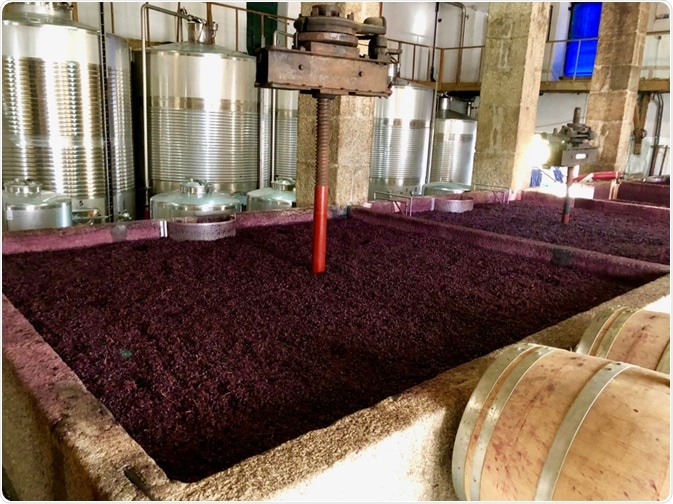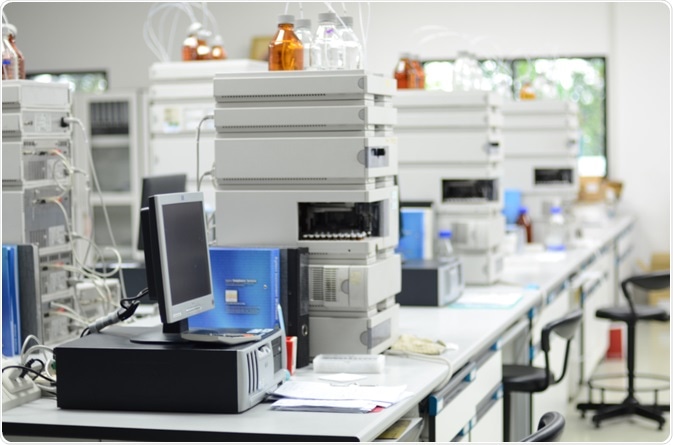Wine is an alcoholic beverage usually produced from fermented grapes. There are many types of wine, some of which include red, white, sparkling, rose` and fortified wine.

Image Credit: Africa Studio/Shutterstock.com
Different grape varieties produce specific types of red or white wine. Some red varieties include Pinot Noir, Shiraz, Cabernet Sauvignon, and Merlot. Conversely, some white varieties include Chardonnay, Riesling, and Sauvignon Blanc.
There are several ways of defining the character of a wine, but five fundamental characteristics of wine are generally used in the wine industry. These include the following: sweetness, acidity, tannin, alcohol, and body.
A range of scientific techniques has been used to investigate various compounds attributed to the character of a wine. However, chromatography techniques still remain the standard approach for investigating molecular characteristics in wine.
Basic Wine Characteristics
Sweetness
The amount of residual sugar left in a wine after fermentation determines the sweetness in the wine. Sweet wine will have a higher level of residual sugar compared to a dry wine, due to a dry wine having converted all the available sugar into alcohol during fermentation.
The sensation of sweetness is experienced on the tip of the tongue with a tingling sensation and is a good indication of the sugar level in the wine. Additionally, sweet wines will be more viscous.
Acidity
The acidity of a wine is usually described as being sharp, tart, or zesty. A common misconception is that the sharpness of taste is due to high alcohol concentration because it manifests as a tingling or fizzy sensation on the sides of the tongue and a rough feel on the roof of the mouth.
However, these taste sensations are often attributed to acidity.
Tannin
The tannin in wine gives a drying effect in the mouth and adds balance and structure. It is often described as astringent and the molecular compounds in tannin are known as phenols, which gives a wine its bitterness.
Alcohol
The level of alcohol in a wine is the greatest contributor to its character. The average alcohol content in wine tends to be around 11 – 14% and gives a warming sensation in the mouth and throat.
Body
Body of wine represents a combination of factors including variety, vintage, region, and alcohol content. A full-bodied wine has a lingering taste in the mouth and is often paired with steak.
There are several techniques used for investigating the character of a wine, but the most commonly used are chromatography techniques.

Image Credit: arcangela/Shutterstock.com
Chromatography of Wine
The principle of chromatography involves the separation of components in a sample mixture based on differences in the polarity of molecules. The process of separation occurs when a sample mixture or mobile phase passes through a stationary phase.
The molecules in the sample mixture have different affinities for the stationary phase and thus have different retention times. Different chromatography methods can have different types of mobile and stationary phases.
In the case of high-performance liquid chromatography (HPLC), the mobile phase is a liquid and the stationary phase is a solid. However, for gas chromatography (GC) the mobile phase is gas and the stationary phase is liquid.
Other chromatography methods can be used for investigating the different characters in wine ranging from very simple methods such as thin-layer chromatography (TLC) to more sophisticated methods such as gas chromatography/mass spectrometry (GC-MS) and liquid chromatography/mass spectrometry (LC-MS).
The most common method used for wine analysis is HPLC, which can distinguish between different wine varieties and when coupled to mass spectrometry can separate more than 100 characteristics in wine that may contribute to flavor.
Chromatography techniques such as HPLC and LC-MS help to identify important compounds such as organic acids present in grapes, which relate to the processing of wines. The presence of certain acids such as malic and lactic acid directly influences the taste, balance, and pH of wine.
Specifically, the use of HPLC and LC-MS can identify impurities such as acetic acid in the production process of wine. Thus, chromatography is also used for quality control and monitoring of pH changes at different stages of winemaking.
Also, HPLC is used for identifying sugars in wine such as glucose and fructose. However, after the fermentation process, these sugars tend to be at low concentrations in wine compared to non-fermentable sugars such as xylose and arabinose.
Another characteristic of wine are volatile organic compounds (VOCs) that give a wine its distinctive aroma. While HPLC is commonly used for wine analysis and identifying certain compounds, gas chromatography can identify VOCs present in wine such as thiols, esters, alcohols, terpenes, sulfur compounds, fatty acids, phenols, and carbonyl compounds.
Each of these VOC families contains specific compounds that produce a variety of distinctive aromas. Some esters can produce fruity and apple-like aromas. While certain terpene compounds give lemon, pine, or lime aromas.
Phenols can give smoky, gammon-like, or clove-like aromas. While carbonyls can give fruity and woody aromas. In particular, the buttery aroma produced in wine is from a carbonyl compound such as 2,3-butanedione and is often associated with the chardonnay grape variety.
Thus, chromatography techniques are commonly used to investigate the many characteristics present in wine that contribute to flavor, which is especially important for monitoring and quality control purposes.

Image Credit: khawfangenvi16/Shutterstock.com
References
- Blanch, G.P.; Reglero, G. & Herraiz, M. (1995). “Analysis of wine aroma by off-Line and online supercritical fluid extraction-gas chromatography”. Journal of Agriculture and Food Chemistry 43, 1251–1258.
- Czerny, M.; Christlbauer, M.; Christlbauer, M.; Fischer, A.; Granvogl, M.; Hammer, M.; Hartl, C.; Hernandez, N.M. & Schieberle P. (2008). “Re-investigation on odor thresholds of key food aroma compounds and development of an aroma language based on odor qualities of defined aqueous odorant solutions. European Food Research and Technology”. 228, 265–273.
- Guth, H. (1997). “Quantitation and sensory studies of character impact odorants of different white wine varieties”. Journal of Agriculture and Food Chemistry 45, 3027–3032.
- Ferreira, V.; Lopez, R. & Cacho, J.F. (2000). “Quantitative determination of the odorants of young red wines from different grape varieties”. Journal of the Science of Food and Agriculture 80 (11), 1659–1667.
- Meilgaard, M.C. (1975). Flavor chemistry of beer: Part II: “Flavor and threshold of 239 aroma volatiles”. MBAA Technical Quarterly 12 (3), 151–168.
- Ribéreau-Gayon, P.; Glories, Y.; Maujean, A. & Dubourdieu, D. (2000). “Varietal aroma. In: Handbook of Enology. Volume 2 – The Chemistry of Wine and Stabilization and Treatments”, John Wiley & Sons Ltd., ISBN 0-471-97362-9, Chichester, England, pp. 187–206.
- Moreno, J.A.; Zea, L.; Moyano, L. & Medina, M. (2005) “Aroma compounds as markers of the changes in sherry wines subjected to biological aging”. Food Control 16, 333-338.
- Ali, K., Maltese, F., Choi, Y.H., Verpoorte, R., 2010. “Metabolic constituents of grapevine and grape-derived products”. Phytochem. Rev. 9, 357–378.
- Silva, F.L.N., Schmidt, E.M., Messias, C.L., Eberlin, M.N., Frankland, Helena, Sawaya, A.C., 2015. “Quantitation of organic acids in wine and grapes by direct infusion electrospray ionization mass spectrometry”. Anal. Methods 7, 53–62.
- Lima, M.D.S., Silani, I.D.S.V., Toaldo, I.M., Corrêa, L.C., Biasoto, A.C.T., Pereira, G.E., Bordignon-Luiz, M.T., Ninow, J.L., 2014. “Phenolic compounds, organic acids and antioxidant activity of grape juices produced from new Brazilian varieties planted in the Northeast Region of Brazil”. Food Chem. 161, 94–103.
- Eyduran, S.P., Akin, M., Ercisli, S., Eyduran, E., Maghradze, D., 2015. “Sugars, organic acids, and phenolic compounds of ancient grape cultivars (Vitis Vinifera L.) from Igdir province of eastern Turkey)”. Turkey. Biol. Res. 48, 1–8.
Further Reading
Last Updated: Sep 13, 2022